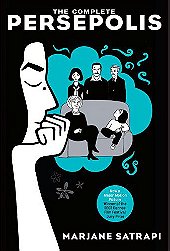I bought this book on a whim. I knew nothing about it other than that it had recently been made into an animated film. Had I flicked through the book before getting it to the counter (something I usually do) I wouldn't have bought it. Why? Because it's a graphic novel. Not that I have anything against graphic novels per se, just as a medium for telling a serious and true story. And had I put this book back I truly would have missed a treat.
The book begins in 1879, at the start of the Iranian Islamic Revolution. It is the story of a young girl's life before and after the revolution. That girl is Marjane Satrapi and at the beginning of the book she is 10 years old. Her parents are liberal, non-religious and determined that Marjane should have a good education. Marjane is in a good position to comment on what is going on around her, not only is she well-educated, she is the great-granddaughter of the last Iranian emperor, who was deposed by the shah, the man against whom the people are revolting.
The book explores how such revolution comes about, and more importantly how it goes wrong. It looks at how jingoistic slogans, if repeated enough times, become mantras. How sacrifice becomes martyrdom, freedom becomes repressive and protest becomes criminal. And all through the eyes of a girl struggling to grow up. A girl just like girls all over the world: Marjane wants to listen to loud music on her walkman, display posters of her favourite bands in her room and make friends with the boys in her street. Some of the most poignant bits are when these small freedoms are taken away.
This is one of the most affective and affecting books I've ever read. The stark black and white imagery does a fantastic job of conveying what Marjane is feeling. It's particularly effective when headscarfs become mandatory: suddenly all the women look the same, it's as if their individuality has been taken away. Possibly because of the lack of space, the prose too is spot on, with not a word wasted anywhere.
One of the things Marjane is trying to do is show that Iranians are just ordinary people, living in very extraordinary times. And this she does admirably well. It's easy for us in the West to see Iran as nothing more than bearded men and headscarfed women, but beneath the hair and clothes there are real people, people like you and me, and this book is a timely reminder of that fact.
9/10
 Login
Login